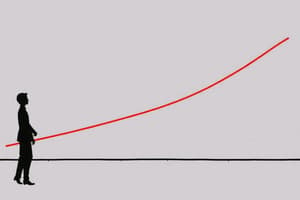Podcast
Questions and Answers
What is included in the multidimensional term 'sexuality'?
What is included in the multidimensional term 'sexuality'?
- Sexual desire, romantic feelings, emotional intelligence, motives
- Sexual desire, attitudes, behaviors, motives (correct)
- Sexual desire, religious beliefs, communication style, motives
- Sexual desire, physical appearance, social status, motives
What does the sexual behavioral system promote?
What does the sexual behavioral system promote?
- Attraction and attachment
- Reproduction and attachment (correct)
- Attraction and independence
- Reproduction and independence
What does the term 'sexuality' encompass?
What does the term 'sexuality' encompass?
- Only reproductive aspects of human sex
- Only physical aspects of human sex
- Only emotional aspects of human sex
- All aspects of human sex (correct)
The investment model of commitment ties commitment to which of the following?
The investment model of commitment ties commitment to which of the following?
According to recent research, infidelity increases divorce odds by what percentage?
According to recent research, infidelity increases divorce odds by what percentage?
The text mentions that infidelity occurs commonly in which type of relationship structures?
The text mentions that infidelity occurs commonly in which type of relationship structures?
What are some relationship-based reasons for engaging in infidelity?
What are some relationship-based reasons for engaging in infidelity?
Which type of extra-dyadic partner is considered worse in the context of infidelity?
Which type of extra-dyadic partner is considered worse in the context of infidelity?
The text suggests that even well-matched partners are not immune to what?
The text suggests that even well-matched partners are not immune to what?
What is a predictor of sexual satisfaction in relationships?
What is a predictor of sexual satisfaction in relationships?
What is linked to sexual satisfaction?
What is linked to sexual satisfaction?
What is afterglow?
What is afterglow?
What is a trend observed among people aged 18-44?
What is a trend observed among people aged 18-44?
What influences sexual satisfaction in relationships?
What influences sexual satisfaction in relationships?
What is associated with better outcomes in relationships?
What is associated with better outcomes in relationships?
What factors influence sexual desire?
What factors influence sexual desire?
Which personality traits are linked to sexual desire?
Which personality traits are linked to sexual desire?
What are the primary motives for engaging in sex?
What are the primary motives for engaging in sex?
What is the relationship between motives for engaging in sex and personal well-being?
What is the relationship between motives for engaging in sex and personal well-being?
What is a risk factor for dissolution according to the text?
What is a risk factor for dissolution according to the text?
What is a weak predictor of dissolution according to meta-analysis?
What is a weak predictor of dissolution according to meta-analysis?
What can sexual satisfaction be closely linked to in ongoing relationships?
What can sexual satisfaction be closely linked to in ongoing relationships?
What are some ways to calculate divorce rates mentioned in the text?
What are some ways to calculate divorce rates mentioned in the text?
What percentage of marriages in the United States experienced divorce between 2005 and 2010?
What percentage of marriages in the United States experienced divorce between 2005 and 2010?
Flashcards are hidden until you start studying
Study Notes
Understanding Divorce Rates and Predictors of Relationship Dissolution
- Sexual satisfaction is closely linked to relationship satisfaction in ongoing relationships.
- Divorce rates are recorded but require thoughtful interpretation due to diverse calculations and missing data.
- Divorce rates can be calculated in various ways, such as crude divorce rate, refined divorce rate, and cohort approach.
- Divorce rates in the United States are around 2.3 per 1000 people, 14 per 1000 women, and 43-46% of marriages between 2005 and 2010.
- Divorce rates in the U.S. rose after the 1970s due to no-fault divorce laws and have declined since then.
- Divorce can have both beneficial and harmful impacts, such as benefiting personal health but also increasing loneliness.
- Factors influencing changes in divorce rates over time include values, delayed marriage, rise in cohabitation, and decline of marriage.
- It is challenging to estimate rates of non-marital dissolution due to the variability in people's experiences and the ignorance of predominately sexual relationships.
- Predictors of relationship dissolution can include problems with "me" or "you", habits and behaviors, and problems with "us".
- Breaking intimacy, characterized by disillusionment and a decline in closeness and affection, is a risk factor for dissolution.
- Incompatibility and conflict are often cited as reasons for dissolution, but conflict is a weak predictor of dissolution according to meta-analysis.
- Understanding predictors of relationship dissolution can involve analyzing breakup reasons falling under the umbrella of personality, habits and behaviors, and problems with "us".
Studying That Suits You
Use AI to generate personalized quizzes and flashcards to suit your learning preferences.




